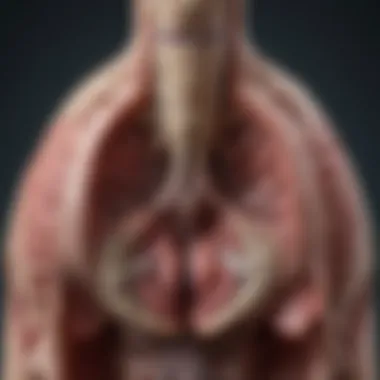Understanding Anorectal Malformations in Newborns


Key Concepts
Definition of Primary Terms
Anorectal malformations (ARM) are a group of congenital anomalies where the anus is absent or not properly formed. This condition can vary significantly, affecting how other gastrointestinal structures develop and work. The most severe cases involve individuals born without any anal opening, necessitating immediate medical evaluation and intervention.
Additionally, ARM may be associated with a range of other congenital issues, referred to collectively as associated anomalies. These can include abnormalities in the urogenital system, spine, and heart. Understanding these terms is key to recognizing the broader implications of this condition on patient care.
Related Concepts and Theories
The classification of anorectal malformations can be understood through various models. The Krickenbeck classification system divides ARMs into types based on the location and type of malformation. This classification helps healthcare providers make informed decisions about surgical interventions and long-term management.
Important theories relating to the etiology of ARMs have been proposed, ranging from genetic factors to environmental influences during gestation. Research has suggested a link between certain maternal conditions and the development of anorectal malformations. Understanding these related concepts allows for a better grasp of how ARMs affect individual patients and the need for tailored approaches in treatment.
Future Directions
Gaps Identified in Current Research
Despite advancements in the understanding and treatment of anorectal malformations, several gaps remain in current research. There is a lack of comprehensive studies regarding the long-term psychosocial outcomes for individuals who are treated for ARMs. While surgical approaches have seen improvement, the impact on quality of life and mental health is less understood.
Another important consideration is the genetic and environmental factors that contribute to the development of ARMs. Further studies could help clarify these connections, potentially leading to improved screening methods for at-risk pregnancies.
Suggestions for Further Studies
Future research should aim to illuminate the multifaceted aspects of living with anorectal malformations. Longitudinal studies focusing on the psychosocial ramifications for patients and their families could provide valuable insights.
Additionally, exploring innovative surgical techniques and their long-term effectiveness is crucial. Integrating patient feedback into these studies could foster improvements tailored to enhance the quality of life for affected individuals.
Prelims to Anorectal Malformations
Anorectal malformations represent a significant congenital issue that impacts individuals from birth. Understanding these conditions is crucial for healthcare professionals, as early detection and intervention can significantly alter the trajectory of affected individuals' lives. This section aims to inform readers about the core aspects and importance of anorectal malformations, particularly in cases where individuals are born without an anus. By outlining definitions and epidemiological data, we prepare a groundwork for deeper discussions on pathophysiology, classification, clinical diagnosis, and management options.
Defining Anorectal Malformations
Anorectal malformations (ARMs) encompass a range of congenital anomalies affecting the development of the anus and rectum. These conditions may occur in isolation or as part of a syndrome involving other anomalies. The spectrum of ARMs includes instances where there is a complete absence of an anus, known as "anal agenesis." This severe form of malformation is often classified into different types based on the underlying anatomical structures and their functionality. Accurately defining ARMs is essential for clinicians to facilitate navigation through treatment options and to comprehensively address the patient's unique clinical presentation.
Epidemiology of Anorectal Malformations
The epidemiology of anorectal malformations highlights their rarity and the implications for public health. According to studies, the incidence of ARMs ranges from 1 in 3,000 to 1 in 5,000 live births. Variations in data may arise due to geographic, environmental, and genetic influences. Additionally, it is significantly more common in males than females, with a ratio of approximately 2:1. Internationally, certain populations may exhibit higher rates, reflecting a potential genetic predisposition. Understanding these statistics is vital for healthcare providers, as it informs screening guidelines and raises awareness regarding the need for access to specialized care.
"Understanding the epidemiology of anorectal malformations helps ensure that affected individuals receive timely intervention and appropriate support throughout their lives."
The insights gained from studies around the epidemiology of anorectal malformations will lay foundation for further exploration in the following sections of this article.
Pathophysiology of Being Born Without an Anus
The pathophysiology of anorectal malformations, especially those involving the absence of an anus, is vital for understanding the challenges faced by affected individuals. This section focuses on the intricate processes that lead to this condition during embryonic development. Grasping these concepts can greatly assist healthcare professionals in making accurate diagnoses and developing tailored management plans.
Normal Embryonic Development of the Anorectal Region
During embryonic development, the anorectal region forms between the fourth and seventh weeks of gestation. The complete formation of the anus is a complex interplay of several anatomical structures. The cloaca, a primitive gut structure, separates into the urogenital and anorectal tracts. This process relies on precise cellular signaling and growth.
A failure in this separation can lead to various types of malformations such as agenesis of the anus. In some cases, the anus may be absent entirely or poorly formed. Continuous research highlights that disruptions in this normal development can be triggered by genetic mutations or environmental influences, emphasizing the critical nature of the embryonic phase.
Genetic and Environmental Factors


Multiple factors contribute to anorectal malformations, particularly in cases of being born without an anus. Genetic predisposition plays a significant role. Studies show that mutations in genes, which regulate embryonic growth and development, can increase the likelihood of such malformations in offspring.
In addition to genetic influences, environmental factors during pregnancy are crucial. Maternal conditions, such as diabetes, obesity, or exposure to toxins, can affect normal development. Certain medications taken during pregnancy have also been implicated as potential risk factors.
As researchers continue to explore the relationship between genetics and environmental factors, it becomes increasingly clear that these elements interact in complex ways. The aim is to identify specific risk factors that could allow for early intervention or preventive measures.
Understanding these causes is beneficial not only for medical professionals but also for families affected by this condition. Addressing both genetic and environmental elements provides a comprehensive view of risks and preparedness as families navigate this journey.
Classification of Anorectal Malformations
The classification of anorectal malformations is crucial in understanding the condition. This framework helps to identify specific types and guide management strategies. By categorizing these anomalies, healthcare providers can formulate effective treatment plans and anticipate potential complications. The classification system also facilitates communication among medical professionals and enhances research efforts by providing a standardized terminology.
Types of Anorectal Malformations
Anorectal malformations can be varied in their presentation and severity. They are generally categorized into several distinct types, which include but are not limited to:
- Imperforate Anus: This is the most common form, where the anus does not exist or is obstructed.
- Anal Atresia: A condition where the anal opening is absent or closed off, preventing the passage of stool.
- Rectovestibular Fistula: This occurs when there is an abnormal connection between the rectum and the vestibule in females.
- Rectourethral Fistula: Similar to the vestibular form, but occurs where the rectum connects abnormally with the urethra in males.
- Cloacal Malformation: A more complex form where the rectum, vagina, and urethra connect abnormally, typically seen in females.
These classifications are not merely academic but hold significant implications for surgical intervention and long-term care. For instance, infants with an imperforate anus often require immediate surgical intervention shortly after birth, while other types may involve staged surgical approaches.
Associated Anomalies
In addition to the specific types of anorectal malformations, it is essential to consider associated anomalies. Many infants born with anorectal malformations may also present with other congenital conditions. Some common associations include:
- Genital Anomalies: Such as undescended testicles or abnormalities in external genitalia, particularly in males.
- Spinal Abnormalities: Conditions like spina bifida can occur, emphasizing the need for a thorough examination of the spinal cord and vertebrae.
- Urinary Tract Anomalies: Including congenital defects of the kidneys or ureters.
- Cardiovascular Issues: Some studies suggest a higher prevalence of congenital heart defects in patients with anorectal malformations.
Understanding these associated anomalies is vital in managing the care of these patients. A multidisciplinary approach involving pediatric surgeons, urologists, and gastroenterologists often proves beneficial in addressing the complex needs of affected individuals.
Given the diverse manifestations of anorectal malformations, their classification and recognition of associated anomalies are essential to providing appropriate clinical care. This segment of the article underscores the importance of a detailed assessment to ensure optimal outcomes for patients and their families.
Clinical Presentation and Diagnosis
Understanding the clinical presentation and diagnosis of anorectal malformations is crucial for timely interventions. Early diagnosis can significantly affect the management and long-term outcomes for individuals born without an anus. Specific signs and symptoms in infants can guide healthcare professionals towards appropriate testing. Consequently, accurate and prompt diagnostics not only inform treatment but also improve the quality of care provided.
Symptoms and Signs in Infants
Infants with anorectal malformations may present with various symptoms. While some signs are directly related to the malformation itself, others could indicate associated anomalies. Typical symptoms to look out for include:
- Absence of an anal opening: This is the most definitive sign. Parents may notice no visible anus in the newborn.
- Abdominal distention: This often occurs due to a buildup of stool that cannot exit the body.
- Failure to pass meconium: Healthy newborns usually pass meconium within the first 24 hours. A delay may point to a deeper anatomical issue.
- Fecal obstruction: This may manifest as irritability or vomiting.
Due to these various presentations, healthcare providers must conduct detailed assessments to differentiate between types of malformations. Parents should be encouraged to communicate any concerns about their infant's bowel habits or abdominal look.
Diagnostic Imaging and Techniques
Accurate diagnosis of anorectal malformations involves several imaging techniques. Common methods include:
- X-rays: These may be used initially to assess the abdomen and identify any blockage.
- Ultrasound: This non-invasive method can help evaluate the anorectal area and visualize surrounding structures.
- Magnetic Resonance Imaging (MRI): MRI provides a detailed view of the pelvis and can be vital for complex cases, helping to identify additional spinal or urinary anomalies.
- Colostography: This specialized imaging involves inserting contrast media into the colon to highlight areas of concern.
These diagnostic tools enable clinicians to understand the exact nature of the malformation. An interdisciplinary approach is often beneficial for thorough evaluations, ensuring that all potential anomalies are considered.
Importance of Early Diagnosis
The early diagnosis of anorectal malformations leads to timely surgical intervention, which can alleviate immediate health risks. Delays in diagnosis may result in complications such as:
- Severe constipation: This could contribute to greater health problems over time.
- Infection risk: Misinformation about the malformation can lead to untreated conditions, resulting in related infections.
- Long-term disabilities: In some cases, late interventions could impact the quality of life well into adulthood.


Early intervention fundamentally improves the prognosis and quality of life for patients with anorectal malformations.
Ultimately, establishing a rapid diagnosis can instill confidence in families and provide a roadmap for subsequent treatment processes. Healthcare systems should strive for effective protocols to ensure that infants receive comprehensive evaluations as soon as possible.
Management and Surgical Interventions
Management and surgical interventions are critical components in addressing anorectal malformations, especially for individuals born without an anus. These interventions not only aim to restore anatomical function, but also to improve the quality of life for the patient as a whole. The care pathway often requires a multidisciplinary approach involving pediatric surgeons, gastroenterologists, and primary care providers. Each decision made in the management process is crucial, as it impacts both immediate health outcomes and long-term well-being.
Surgical Techniques for Reconstruction
The surgical approach for children born without an anus typically involves several possible techniques, including:
- Colostomy: This may be performed as an initial procedure. A portion of the colon is brought to the abdominal wall to allow for waste elimination outside the body.
- Anorectal Reconstruction: This aims to create a functional anus from the surrounding tissue. This may include a posterior sagittal anorectoplasty (PSARP) procedure, which reconstructs the anal canal and sphincter system.
- Pull-Through Procedure: In cases where there is a functional rectum, the intestine can be pulled through to the body's exterior, allowing for direct passage of stool.
Each technique is selected based on individual anatomy and associated anomalies, if present. Successful outcomes often require careful preoperative assessment and imaging studies, which aid in planning the best approach. The choice of technique affects not only immediate outcomes but also future bowel function, thus highlighting the importance of skilled surgical intervention in this field.
Post-Surgical Care and Complications
Post-surgical care is vital to monitor the recovery process and to identify any complications early. Common considerations during this phase include:
- Monitoring for Infection: The surgical site should be regularly assessed for signs of infection. This includes redness, swelling, and discharge.
- Bowel Function Assessment: Patients may experience various bowel habits following surgery. It is critical to monitor stool patterns and manage any constipation or diarrhea appropriately.
- Nutritional Support: Special diets may be necessary to support recovery and ensure proper growth, especially in infants.
Complications can arise, even in well-planned surgeries. Some possible challenges include:
- Stenosis: Narrowing of the anal canal can lead to obstruction.
- Incontinence: This can occur if the anal sphincter is not functioning properly.
- Fistulas: Abnormal connections between the rectum and other organs may develop, requiring further surgical intervention.
"Long-term follow-up is essential for monitoring functional outcomes and addressing any complications that may arise over time."
Long-Term Outcomes and Quality of Life
Understanding the long-term outcomes for individuals born with anorectal malformations, especially those without an anus, is critical for improving their quality of life. This perspective not only focuses on physiological health but also incorporates psychological and social dimensions, ultimately contributing to a holistic approach to care.
Physical Health Outcomes
The physical health outcomes for individuals born without an anus can widely vary. Early surgical intervention often defines the success of management strategies. Many individuals require a multimodality approach that includes:
- Surgical Procedures: Initial surgeries like colostomy, followed by reconstructive procedures, are essential. Subsequent surgeries may be needed as the child grows, influencing long-term gastrointestinal function.
- Continued Monitoring: Regular follow-up with healthcare providers is crucial. Monitoring for complications like bowel obstruction, incontinence, and urinary issues is part of ongoing care.
- Nutritional Support: Individuals may face challenges with nutrition absorption. Therefore, tailored dietary recommendations are important in promoting overall health.
While these individuals may achieve relative normalization of bowel function, understanding variances in physical outcomes is essential. Some patients may continue to face chronic issues, impacting their activities of daily living.
Psychological and Social Impact
The psychological and social impacts of being born with an anorectal malformation cannot be overstated. These impacts may stem from medical complications as well as societal attitudes. Consideration of the following aspects is vital:
- Mental Health Challenges: Individuals may experience anxiety or depression related to their condition. Coping strategies, along with psychological support, can be invaluable. Many may benefit from counseling aimed at addressing these issues.
- Social Functioning: Children and adults alike may confront stigma and misunderstanding from peers or within their communities. This can lead to social isolation or issues with self-esteem. Educational support for both patients and their peers can help mitigate this effect.
- Transition to Adulthood: The transition to adult care also plays a significant role. Many young adults require assistance in navigating healthcare systems and advocacy for their ongoing needs.
In summary, the long-term outlook for individuals born without an anus requires comprehensive and continuous evaluation. Focusing on health outcomes, psychological well-being, and social aspects contributes to enriching their lives. It is vital that families and healthcare providers work together to promote the best possible quality of life.
Greatly enhancing the quality of life for affected individuals involves both early surgical intervention and ongoing supportive care across physical and emotional domains, ensuring these individuals lead fulfilling lives.
Support Resources for Families and Patients
Support resources for families and patients dealing with anorectal malformations are crucial. These resources can help caregivers understand the complexities of the condition and provide necessary guidance for effective management. The psychological and emotional stress experienced by families is significant; therefore, establishing a support system is imperative. It ensures that they feel less isolated while navigating this challenging journey, which can often be overwhelming.
Caregivers must not only focus on medical care but also consider emotional well-being. Engaging with support organizations and networks can help families connect with others facing similar situations. Sharing experiences, receiving advice, and finding a community can make a significant difference. Furthermore, educational resources serve to empower families with essential knowledge related to their child's condition, which can foster confidence in advocacy for appropriate care.


"The emotional and practical support offered by networks can be essential in ensuring effective management of anorectal malformations."
Support Organizations and Networks
Numerous support organizations exist specifically for families grappling with anorectal malformations. These organizations provide crucial resources, ranging from information about the condition to personal connections with other families. Here are some notable groups:
- The American Academy of Pediatrics: This organization offers resources tailored to children's health, including congenital conditions like anorectal malformations.
- The Children’s Gastroenterology and Nutrition Foundation: Focuses on children’s gastrointestinal health and provides resources for families affected by anorectal malformations.
- Support groups on platforms like Facebook and Reddit: These online communities allow parents and patients to share personal stories, advice, and emotional support.
Finding the right organization can ease some burdens and reinforce families with the knowledge that they are not alone in their journey.
Counseling and Educational Resources
In addition to support networks, counseling services and educational resources are critical for families. They can provide insights into the psychological impacts of anorectal malformations and coping strategies.
- Counseling Services: Professional counseling for both patients and families can be beneficial in addressing fears, anxieties, and stresses related to the condition. Therapists can help with emotional management and offer strategies to cope with challenges.
- Educational Materials: Fact sheets, brochures, and online webinars can familiarize families with anorectal malformations. Knowledge about medical terms, surgical options, and potential complications can help families make informed decisions.
Furthermore, collaboration with healthcare professionals is vital. Families can ask their doctors for recommendations for local therapists or educational programs relevant to their needs.
Equipping oneself with information and support enhances the journey towards managing anorectal malformations. This can lead to more effective advocacy for the best possible care and outcomes for affected individuals.
Research and Future Directions
Research into anorectal malformations is critical for advancing medical understanding and improving patient outcomes. This area of congenital disabilities demands attention not only for its rarity but also for its complex nature. By delving into research initiatives, healthcare professionals can better grasp the multifaceted challenges faced by patients and their families.
The benefit of focusing on future directions in this field is twofold: it can enhance clinical practices and provide a better quality of life for individuals affected by these conditions. As the medical community continues to uncover the underlying causes and effective intervention strategies, the importance of ongoing studies cannot be understated.
Current Research Initiatives
Current research initiatives are diverse, focusing on various aspects of anorectal malformations. Universities and health institutions are leading studies that explore genetic factors contributing to these anomalies. Specific studies are looking at the correlation between prenatal diagnostics and early intervention outcomes.
Some key areas of focus include:
- Genetic Testing: Identifying mutations linked to anorectal malformations.
- Multidisciplinary Approaches: Evaluating how collaborations between pediatric surgeons, geneticists, and psychologists can optimize patient care.
- Longitudinal Studies: Assessing health outcomes as patients age, which can uncover the long-term effects of treatment.
These initiatives provide insight into improving surgical techniques and postoperative care. The engagement of both parents and healthcare providers plays a vital role in shaping research outcomes.
Potential Advances in Treatment Options
As research unfolds, potential advances in treatment options are becoming clearer. Innovations in surgical techniques are being developed to address complications effectively. Minimally invasive procedures are gaining traction, offering quicker recovery times and reduced hospital stays.
Potential advancements in treatment may involve:
- Personalized Medicine: Utilizing genetic information to tailor treatments specific to individual patients.
- Regenerative Medicine: Exploring stem cell therapy as a means to repair or regenerate damaged tissues in the anorectal area.
- Enhanced Postoperative Care Protocols: Creating standardized care plans that address the unique needs of patients post-surgery.
Research directed at these areas not only provides hope for better outcomes but also fosters a comprehensive approach to managing anorectal malformations.
"Future research will bridge gaps in our understanding and lead to practical interventions that transform the lives of those affected by anorectal malformations.”
Continued funding and support for these research initiatives is essential. Collaborating across various medical disciplines will help ensure that groundbreaking findings translate into clinician practices, ultimately improving the quality of life for affected individuals.
Finale
The exploration of anorectal malformations, especially in individuals born without an anus, is vital in addressing both medical and psychological aspects of this complex condition. Understanding the multifaceted nature of this disorder not only aids in effective diagnosis and management but also enhances the quality of life for those affected.
Summary of Key Points
- Anorectal malformations encompass a spectrum of congenital defects that can severely affect an individual's health.
- Accurate diagnosis is essential for guiding treatment, which often includes surgical reconstruction of the anorectal area.
- Long-term outcomes hinge on both physical health and psychological well-being, highlighting the importance of ongoing support and resources.
- Family involvement and education are critical for better outcomes, fostering a supportive environment for the affected individuals.
- Current research initiatives are paving the way for potential advances in treatment options, emphasizing the need for continued exploration in this field.
Implications for Practice and Research
The findings presented regarding anorectal malformations have several implications:
- For Healthcare Practitioners: There is a need for heightened awareness among healthcare providers about the signs and symptoms of anorectal malformations. Early recognition can lead to prompt intervention and better patient outcomes.
- For Researchers: Continued investigation into the genetic and environmental factors contributing to these conditions is imperative.
- For Educators: Curriculum surrounding congenital anomalies should integrate information on anorectal malformations to prepare future healthcare providers adequately.
- Enabling a multidisciplinary approach involving surgeons, pediatricians, psychologists, and nutritionists can help address the diverse needs of affected individuals.



